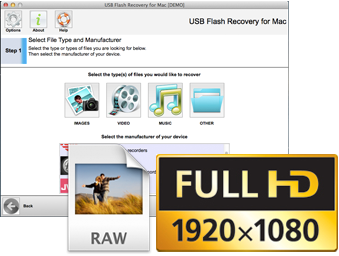
- Usb flash recovery mac how to#
- Usb flash recovery mac for mac#
- Usb flash recovery mac mac os x#
- Usb flash recovery mac software#
- Usb flash recovery mac zip#
If none of them work, either all the disks are bad (less likely) or the drive is faulty (more likely). It might just be the one disk that is bad.
Usb flash recovery mac zip#
If this happens, try reading other Zip disks, ideally ones that were stored in a different condition. If you hear lots of clicking from your Zip drive while attempting to read a disk, you could have a bad Zip drive or a bad disk.
Usb flash recovery mac how to#
RELATED: How to Copy or Move Files and Folders on Windows 10 Troubleshooting
Usb flash recovery mac for mac#
For Mac disks, it’s best if you read them on a vintage Mac then copy the files over to your Windows PC via a USB drive or a LAN. Windows 10 or 11 can’t read Mac format Zip disks unless you use a special utility called HFSExplorer, with mixed results. Windows can read Zip disks formatted with FAT, FAT32, exFAT, or NTFS formats commonly used by MS-DOS and Windows over the decades. For example, you can drag the file icons where you want them to go, or right-click and copy, then paste to a destination.

You can copy the files just as you would with any other disk or drive. Then insert a Zip disk, and the drive will appear in “This PC” in File Explorer, usually labeled as “USB Drive.”ĭouble click the Zip drive’s icon in File Explorer and you’ll see the contents of your Zip disk. First, plug your USB Zip drive into a spare USB port on your PC. If you’re on Windows 10 or 11, it’s really easy to copy data from a Zip disk. RELATED: What Is a File System, and Why Are There So Many of Them? How to Copy Data from a Zip Disk to Windows So if you have any IBM PC- or Windows-formatted ZIP disks, you can insert them into a Zip drive plugged into your Mac and copy the files over easily. Ironically, while recent versions of macOS don’t natively support legacy Mac-formatted Zip disks, they do support legacy MS-DOS and Windows disks. Once on the intermediary Mac, you can copy the files to a USB flash key or over a LAN to your modern Mac. Once you have the vintage Mac in hand, just plug your USB Zip drive into the Mac, open the drive icon that appears in Finder (or on your desktop), and drag your files over to copy them. A Core 2 Duo Mac Mini is a good low-cost machine that can serve as an intermediary between HFS-formatted Zip disks and a modern Mac. They are plentiful, so keep an eye out for a good deal on one in working condition. That’s not as bad as it sounds: as of December 2021, you can get an early Intel Mac Mini (such as a Core Solo or Core 2 Duo model) for around $50-$100 on eBay. More easily, you can buy a cheap, used Intel Mac Mini running an older version of macOS, then copy the files over to a modern machine via a USB key or LAN. But that’s a very technical and difficult solution for most people. If you don’t have one, you can attempt to run an earlier version of macOS in a virtual machine, then link it to your USB Zip drive.

To read HFS or HFS+ Zip disks, you’ll need to use a Mac running macOS 10.14 Mojave (2018) or earlier. It’s likely your Mac Zip disks were written in HFS format on a PowerPC Mac. So if you formatted a Zip disk using a Mac before 2009, the odds are very high it’s in HFS or HFS+ format.
Usb flash recovery mac mac os x#
But until Mac OS X 10.6 Snow Leopard (2009), the Mac operating system supported writing to HFS and HFS+ disks.
Usb flash recovery mac software#
What is a file system, you ask? It’s a software method that determines how an operating system writes data to (and reads data from) a storage medium such as a disk or hard drive. That’s because most Mac-formatted Zip disks use the now-obsolete HFS or HFS+ file system format that macOS today can’t read. If you’re trying to read vintage Mac-format Zip disks with a recent Mac running an up-to-date version of macOS, you’ll run into a significant roadblock very quickly. RELATED: Even 25 Years Later, the Iomega Zip Is Unforgettable How to Copy Data From a Zip Disk to a Mac We’ll start with Mac first because that has the most caveats.

We’ll cover each scenario in a different section below. Once you have a USB Zip drive in hand, how you proceed depends on if you’re working from a Windows PC or a Mac. Those non-USB models won’t work with modern PCs or Macs. Just make sure you don’t buy a Zip drive with a parallel port or SCSI connection by accident. The higher capacity drives can read the smaller capacity disks (such as 100 MB) easily. Almost any Zip drive with a USB connection will work, including the 100 MB, 250 MB, and 750 MB models. As of December 2021, you can get a USB Zip Drive on eBay for anywhere between $50 and $200 depending on condition and type.


 0 kommentar(er)
0 kommentar(er)
